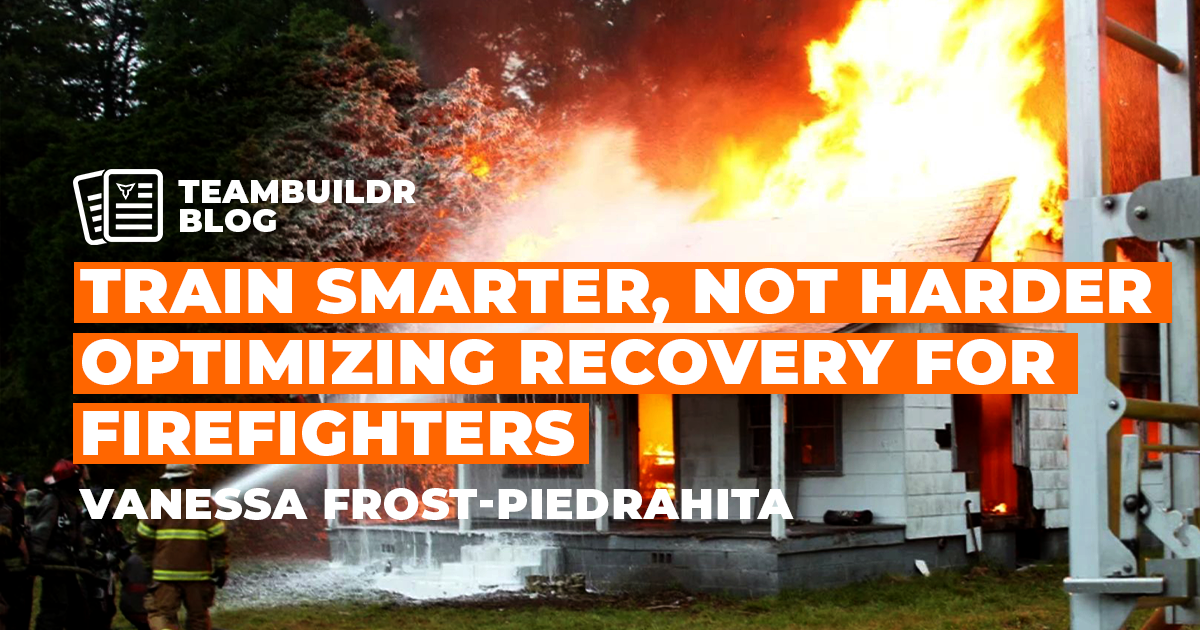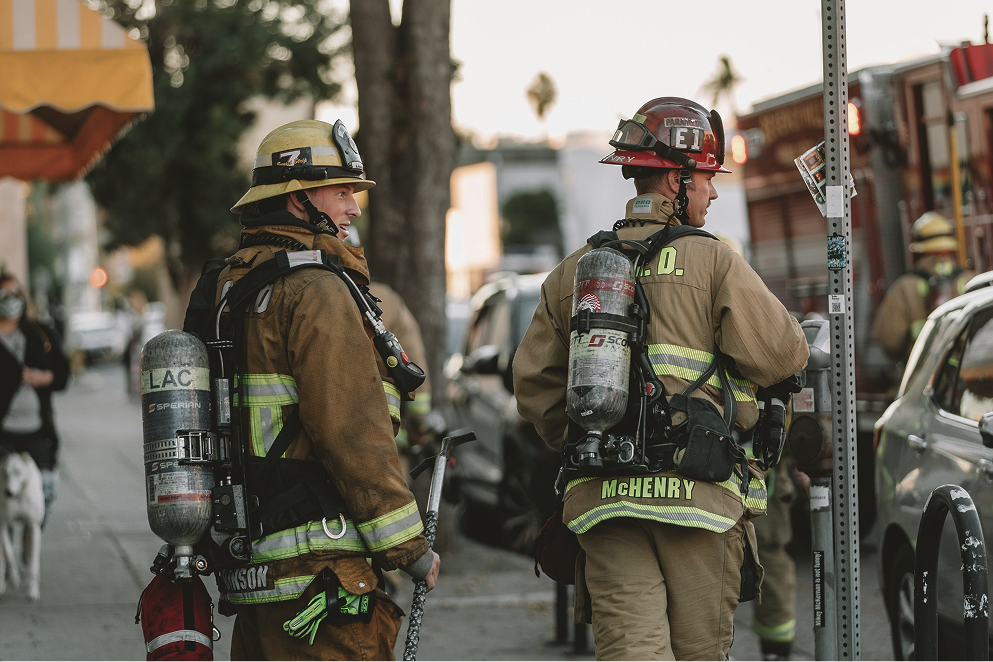How to Coach Firefighters: Building Strength, Endurance, and Resilience
As strength and conditioning coaches, many of us cut our teeth in the world of competitive sport - whether that’s collegiate weight rooms, professional teams, or youth and high school athletics. Over the years, we’ve stepped beyond the boundaries of the playing field to work with the general population and into tactical professions, such as the military, law enforcement, and firefighting.
That’s where I am now, coaching firefighters. I made the transition from collegiate sports about nine years ago, and here’s the thing: coaching firefighters is not the same as coaching collegiate athletes. Sure, both need to be strong, have endurance, and be resilient mentally and physically, but the fireground doesn’t have a season. Firefighters don’t get warm-ups before emergencies, and they don’t get timeouts in the middle of a call. The environment they operate in is hot, heavy, unpredictable, and might be happening at 2 am. Their opponent can’t just outscore them; it can kill them.
If you’re a coach stepping into this world, you need more than just a good program. You need to understand the mission, the culture, and the real-life demands firefighters face on and off the shift. This blog is here to help you do just that.

Understand the Job Before You Program for It
Before you ever touch a program template, you need to understand the demands of the job. Firefighting isn’t about peak performance for a single game or even one season. It’s about being physically ready for the next call, whether it’s the first or tenth call of the day, at 2 p.m. or 2 a.m., and not just for today, but for 30 years.
Here’s what changes when you coach firefighters:
- Unpredictable Schedules = Inconsistent Recovery
Shift work, call volume, and station culture all affect how much (or how little) rest they get- and that matters when you’re programming intensity, volume, or even basic expectations.
- Gear and Load = Altered Movement and Fatigue
SCBA, turnout gear, tools - they change biomechanics, add stress, and make simple movements exponentially harder. Training needs to account for that load, range of motion, and compensations that build up over time.
- House Fire, Medical Call, or 100-acre Grass Fire = Different Potential Energy Demands
Depending on the call type, the energy demands of a firefighter change drastically. They could be asked to work for multiple hours of low to moderate physical work, or 15 minutes of high intensity, and equally prepared for both.
- Load Management + Progression = Longevity
Programming should prioritize operational capacity, not just performance gains. It’s about showing up ready year after year without falling apart, not just peaking on test day.
Firefighters don’t need fluff, and they surely don’t need a program that ignores the realities of their job. If you want to serve this population well, your strength and conditioning knowledge needs to be filtered through the lens of the fireground.
If They Don’t Trust You, They’re Not Listening To You
You could write the most technically sound, research-backed program in the world - but if your firefighters don’t trust you, it won’t matter - no matter how smart your programming is.
Here’s what to know:
- Although fire stations have gyms, they aren’t gyms.
They’re second homes. If you barge in like you’re the expert and they’re the project, you’ll lose the room before you even start.
- Be present before you prescribe.
Take time to observe. Ask questions. Listen. Show up for their skills training, for meals, for conversations that have nothing to do with strength and conditioning. The goal is that they trust you, and you happen to be a strength coach. Hop in on their training if you can!

- Don’t flinch when they test you.
Firehouse culture often includes a bit of testing, sarcasm, challenges, and pushback. Don’t take it personally. Earn your place with humility, consistency, and a little grit. They’ll come around.
All that to say, if you’re walking in with a clipboard and a plan but no relationships, you’re wasting your time. Trust unlocks buy-in, and buy-in is what gets results.
Program with flexibility & purpose
Many coaches enter their work with the fire service through coaching academies - other than learning the requirements of the job and how taxing each skill day is, academy settings are ones coaches are familiar with - large group sessions with set schedules. Once they make it onto the lines, it is a whole other beast. Shift work, call volume, sleep deprivation, and family demands all hit differently - and your programming needs to flex with that reality.
The best firefighter training program is one that can survive 3 calls after midnight, a surprise mandatory OT, or a week of crappy shifts. It’s not about intensity for intensity’s sake - it's about progressing, without draining their nervous system even further.
That means you need to write with flexibility:
- Plan for varying levels of fatigue - one night they may have gotten zero calls while another night they had a ton, so there needs to be wiggle room within a program. I like to use autoregulation tools like RPE or RIR so they can adjust based on how they feel that day.
- Build around what they can do - Almost everyone in the fire service has some kind of ache and pain, so offer not only modifications to a single movement, but also other options of movements that help get the job done based on injury, equipment, or even preference.
- Offer structure, but make it flexible- give them options. That might mean ‘just in case’ workouts they can use on days where the shift was really rough, extra credit for days they’re able to give the extra push, or swapping everything you were planning on when you make a station visit because they just ran a traumatic call and needed some processing time instead.
There are times to push when the energy is there, but there are times they don’t need to train harder, but smarter. For a deeper dive into how recovery and fatigue management affect firefighter performance, check out Train Smarter: Optimizing Recovery for Firefighters.
Education is part of the job
If you have the opportunity to work with firefighters, you’re likely operating outside of standard coach-to-athlete ratios, so your goal is to teach them to fish, not just feed them. Firefighters are smart, skilled professionals who are used to operating with purpose. They also have general anatomy and physiology knowledge - use that! Teach them not only the what, but the how and why behind a program.
Here’s what that looks like in practice:
- Connect the dots: Don’t just program a split squat and tell them to do 3x8 - make reference to how unilateral strength reduces injury risk of everything on the fireground.
- Speak firefighter, not just exercise science: They likely don’t care to hear ‘posterior chain activation.” They care that their back doesn’t hurt after the next lift assist when they help pick up a 500lb person off the ground.
- Layer in education: Whether it’s a quick video you upload into their TeamBuildr, a one-liner message, or a short explanation in the middle of a session, those small teaching movements build long-term buy-in.

It’s about clarity and giving them the tools to understand why you’re asking them to do the things you are. They’ll likely still complain while they do it (like any population we work with), but they'll be more likely to do it when you’re not there.
Respect the Mission and the Long Game
It’s easy to get wrapped up in performance - how much they lift, how fast they move, how their newfound strength helps them on their fireground performance. And in the academy, that kind of output is very important. You’re building capacity, grit, and working towards standards. But once their boots hit the stations? Your job as a coach shifts.
Yes, firefighters on shift continue to need strength and endurance to perform on the fireground. But more than that, they need to stay healthy. Injuries, fatigue, blood pressure, back pain, metabolic syndrome, and the like are what affect the length of their careers and the quality of their lives.
As a coach, you have a chance to:
- Reduce wear and tear that ends careers early
- Teach movement patterns that save joints, not just build muscles
- Make training doable, not just demanding
- Be a steady reminder that their health is important
Fireground readiness is important, but our biggest win as coaches isn’t a faster time on a fitness assessment. It’s someone still being able to do the job - and enjoy life- after 25 years in the service.
Coach for their Career
Firefighters don’t need another hero workout. They need a coach who gets it- who sees the job for what it is, understands the toll it takes, and builds training that helps them stay strong, mobile, and functional for the long run.
If you’re walking into this field thinking it’s about PRs and flashy circuits, you’ll miss what actually matters. But if you lead with curiosity, humility, and focus on long-term health, you’ll earn trust and make a real difference.
They don’t need perfect programs; they need sustainability.
They don’t need high intensity every day; they need consistency for decades.
That’s what gives them not only operational readiness, but their health - the real mission.
Subscribe to our blog
Subscribe to receive the latest blog posts to your inbox every week.
Related posts

Train Smarter: Optimizing Recovery for Firefighters

Transforming First Responder Fitness & Wellness with TeamBuildr Strength & AMS

